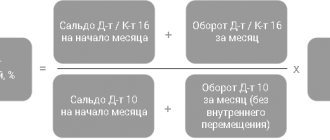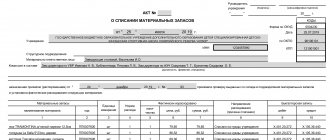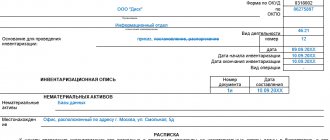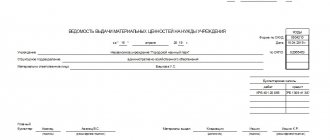Basic Concepts
Reserves are needed to ensure the reliability of asset valuations. Let's consider the criteria for creating a reserve for valuables:
- The value of valuables has actually decreased. This may be due to the obsolescence of the object, loss of consumer qualities, or a decrease in value by similar values on the market.
- Material assets do not belong to the consolidated accounting groups listed in paragraph 20 of the instructions of the Ministry of Finance. For example, they are not groups of basic or auxiliary materials, finished goods, or segment inventories.
- There are reasons to accurately determine the cost. For example, the cost can be determined on the basis of internal documentation, external information, and company accounting registers.
The procedure for creating a reserve is specified in clause PBU 5/01.
Question: How to reflect in accounting the creation of a reserve for depreciation of inventories due to the loss of materials of their original qualities, as well as their subsequent sale? Materials were purchased at a price of 300,000 rubles. (excluding VAT). At the end of the reporting year, a loss of their original qualities was revealed. Because of this, the materials cannot be used in production. They are supposed to be sold. Net sales value, defined as the price at which similar materials can be purchased, at the end of the reporting year amounted to 200,000 rubles. (excluding VAT). The following year, the materials were sold under a sales contract for RUB 240,000. (including VAT 40,000 rub.). Tax accounting uses the accrual method. View answer
Creation Rules
Provision for impairment of tangible assets is a method of analyzing and grouping impaired property. It should be created only when the cost of its possible implementation falls or becomes lower than the actual cost. At the same time, large categories of property should not be allowed to depreciate. For example, you cannot write off all fixed assets or materials to the reserve.
The enterprise undertakes to provide an estimate of the cost of funds for the amount of which the insurance fund is created. The reserve for reducing the cost of material assets is formed at the expense of the financial results of the enterprise.
Provision for impairment of value
Valuables whose price has decreased must be recorded in the balance sheet at the end of the year. Reflection is carried out at the current market value. In this case, the actual wear and tear of the valuables is taken into account. The basis of the provision must be consistent with the prudence principle. The essence of this principle is that recognition of expenses rather than income is paramount. Hidden reserves cannot be created. The procedure for creating a reserve for reducing the value of valuables:
- Valuable balances are tested for signs of depreciation. These signs can be internal and external. Local signs: unused valuables that have lost their consumer properties, the presence of damage on them. External signs: a decrease in market prices for similar values, technological progress that makes objects irrelevant. Testing is carried out as part of the inventory. It is carried out at the end of the reporting year. If the market value of the property is greater than the actual value, there is no need to create a reserve.
- It is required to establish the market value of the assets, on the basis of which signs of depreciation were detected. When determining the cost, you can use the prices indicated in official sources. It is also possible to use data obtained from independent specialists. For example, these could be experts. The validity of the calculation of market value must be confirmed by documents.
- The current market value is compared with the cost of the assets. Cost refers to the data contained in accounting. If the cost exceeds the market value, a reserve is created for the difference.
- A reserve is being formed. It needs to be created for each value. The formation of reserves for enlarged groups is not allowed. For example, building materials cannot be taken as a unit. However, it is possible to combine units of value if they are homogeneous. For example, you can combine equipment with the same characteristics.
Each of the stages of cost reduction is mandatory.
Determining the current value of assets
Market value is determined based on the following factors:
- Statistical information published by Rosgosstat.
- Information published by the media.
- Methods of analytical calculations.
- Data provided by experts and appraisers.
IMPORTANT! The method for determining market value must be recorded in the accounting policy.
Determining the size of the reserve
The volume of the reserve is established for each item of value. The formula for calculations looks like this:
Book value – current market value * number of values
The current market value refers to the amount that can be obtained from the sale of valuables at the moment.
Rules for creating reserves
One of the main documents regulating accounting at an enterprise is the accounting policy. It contains detailed information about:
- Is it possible to create reserves and what kind;
- how often to re-evaluate inventory items;
- what sources of information about current prices to rely on when making calculations;
- and other specific and general rules for the formation of this reserve.
Let's look at an example of the main part of the accounting policy regarding this fund:
- The reserve is formed on the basis of property balances at the end of each quarter after its revaluation, which must be completed no later than the 25th day of the month following the reporting date.
- A check for loss of value of assets is carried out only for those assets whose value at the date of the report exceeds 250 thousand rubles.
- To accurately determine the market value of inventory items, the following can be used: prices of similar assets purchased in recent deliveries, the average value of property in the region, data from the latest resource calculation for similar values. If additional costs are required for the sale of assessed inventory items, then their amount should be deducted from the market value.
- Based on the data obtained, a reserve is created for each item number or group of similar property to reduce the value of material assets. The posting used is as follows: account 91.2 is debited, account 14 is credited. A prerequisite is a positive difference between the first and second indicators.
- Expenses and income generated as a result of the creation and liquidation of a reserve give rise to a permanent liability in the form of a tax or tax asset.
Compliance with the accounting policies for creating a fund is a mandatory requirement for an accountant.
Adjustment of reserve for reduction in value
So, the reserve was founded. However, it can be changed if the following circumstances are present:
- Write-off of the reserve. Performed in the event that valuables are written off from the balance sheet due to their direction for production, sale, or transfer free of charge. Write-offs are made to other income.
- Creating an adjustment. Performed if the value of valuables has increased. The difference between actual and market value decreases. The reserve must be reduced.
If at the end of the reporting period the value of objects is reduced, but they are not written off, the reserve is allocated to the next period.
Calculation of the reserve amount
As a rule, the accountant resorts to creating reserves before preparing year-end reports. During the revaluation of inventory items and detection of depreciation of certain property, it becomes necessary to write off amounts to the reserve for a decrease in the value of material assets. The entry describing this process consists of account 14 being debited and account 91 being credited.
The total value of property transferred to the reserve is determined by the formula: P = Sryn. – Sfact., where:
- Sryn. – market value of the asset;
- Sfact. – actual cost of the property.
If it turns out that the actual cost of a unit of inventory items turns out to be greater than the market value, the accountant does not have the right to create a reserve. The values used in the calculation must be taken from current and reliable sources containing official data on exchange and market processes.
Accounting
To record information about reserves for depreciation in value, account 14 “Reserve for depreciation of value on assets” is used. The formation of the reserve is recorded in accounting as follows:
- DT91 KT14. A reserve has been created.
- DT14 KT91. Restoring the reserve amount in the process of writing off valuables.
DT14 KT91 – a record that is relevant when the market value increases. It is used at the end of the reporting period if the reserve has not been used.
Examples of accounting entries
When working with reserves to reduce the value of valuables, these following accounting entries are used:
- DT 91 (subaccount “Other expenses”) KT14. A reserve has been formed to reduce the cost.
- DT99 (sub-account “Permanent tax obligations”) KT68. Fixation of tax obligations.
As the products are used, the reserve is restored:
- DT62 KT90. Recognition of revenue from sales of products.
- DT90 (sub-account “VAT”) KT 68 (sub-account “VAT”). VAT on proceeds from the sale of products.
- DT90 KT41. Write-off of the cost of valuables.
- DT14 CT 91 (subaccount “Other income”). Write-off of a previously formed reserve to reduce the value of valuables.
- DT68 KT99 (sub-account “Tax obligations”).
The main account for a decrease in value is active-passive account 14. The formation of a reserve is recorded by credit, and the restoration or increase in value is recorded by debit.
Primary documents
Each accounting entry is based on primary documentation. The supporting documents confirm the indicated amounts and transactions. Let's look at an approximate list of primary items:
- Leader's order.
- Certificate from the accounting department.
- Various payment documents.
If information from primary documents contradicts accounting data, regulatory authorities will have questions.
general characteristics
Reserves are part of the enterprise’s sources, grouped by purpose in special insurance funds. The main purpose of their formation is considered to be the recognition by the enterprise of the possibility of an unfavorable financial situation: an excess of expenses over income. In particular, a reserve for a decrease in the value of material assets is created when their market values the property below the value of its actual cost. Most often this happens due to damage to property or its physical and moral obsolescence.
The value of the asset in the balance sheet is reflected minus the amounts taken into the reserve for the reduction in the value of material assets. The posting when created looks like this: the other expenses account is debited, account 14 is credited.
Tax accounting
Chapter 25 of the Tax Code of the Russian Federation does not imply a reduction in taxable profit. That is, a reserve that reduces accounting profit but is not taken into account when creating taxable profit is considered a permanent difference. In the period in which the permanent difference was formed, a tax liability arises. This is a tax that provokes an increase in tax payments. Let's look at transactions related to taxation:
- DT99 (sub-account “Tax obligations”) KT68.
- DT68 KT99 (required to create a subaccount). The posting is used when restoring the reserve.
Both tax and accounting must comply with regulations.










